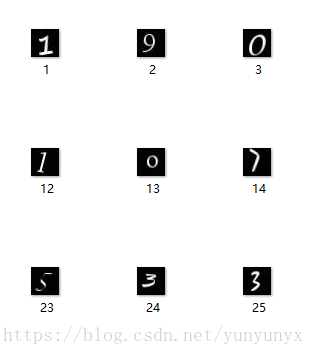1
2
3
4
5
6
7
8
9
10
11
12
13
14
15
16
17
18
19
20
21
22
23
24
25
26
27
28
29
30
31
32
33
34
35
36
37
38
39
40
41
42
43
44
45
46
47
48
49
50
51
52
53
54
55
56
57
58
59
60
61
62
63
64
65
66
67
68
69
70
71
72
73
74
75
76
77
78
79
80
81
82
83
84
85
86
87
88
89
90
91
92
93
94
95
96
97
98
99
100
101
102
103
104
105
106
107
108
109
110
111
112
113
114
115
116
117
118
119
120
121
122
123
124
125
126
127
128
129
130
131
132
133
134
135
136
137
138
139
140
141
142
143
144
145
146
147
148
149
150
151
152
153
154
155
156
157
158
159
160
161
162
163
164
165
166
167
168
169
170
171
172
173
174
175
176
| # -*- coding: utf-8 -*-
from PIL import Image
from pylab import *
import numpy as np
import xlrd
#读取图片的灰度值矩阵
def read_photo():
for i in range(5000):
j = i+1
j = str(j)
st = '.jpg'
j = j+st
im1 = array(Image.open(j))
#(28,28)-->(28*28,1)
im1 = im1.reshape((784,1))
#把所有的图片灰度值放到一个矩阵中
#一列代表一张图片的信息
if i == 0:
im = im1
else:
im = np.hstack((im,im1))
return im
#读取excel文件内容(path为文件路径)
def read_excel(path):
# 获取所有sheet
workbook = xlrd.open_workbook(path)
sheet_names = workbook.sheet_names()
# 根据sheet索引或者名称获取sheet内容
for sheet_name in sheet_names:
isheet = workbook.sheet_by_name(sheet_name)
#获取该sheet的列数
ncols = isheet.ncols
#获取每一列的内容
for i in range(ncols):
if i == 0:
xl1 = isheet.col_values(i)
xl1 = np.array(xl1)
xl1 = xl1.reshape((10,1))
xl = xl1
else:
xl1 = isheet.col_values(i)
xl1 = np.array(xl1)
xl1 = xl1.reshape((10,1))
xl = np.hstack((xl,xl1))
return xl
#layerout函数
def layerout(w,b,x):
y = np.dot(w,x) + b
t = -1.0*y
# n = len(y)
# for i in range(n):
# y[i]=1.0/(1+exp(-y[i]))
y = 1.0/(1+exp(t))
return y
#训练函数
def mytrain(x_train,y_train):
'''
设置一个隐藏层,784-->隐藏层神经元个数-->10
'''
step=int(input('mytrain迭代步数:'))
a=double(input('学习因子:'))
inn = 784 #输入神经元个数
hid = int(input('隐藏层神经元个数:'))#隐藏层神经元个数
out = 10 #输出层神经元个数
w = np.random.randn(out,hid)
w = np.mat(w)
b = np.mat(np.random.randn(out,1))
w_h = np.random.randn(hid,inn)
w_h = np.mat(w_h)
b_h = np.mat(np.random.randn(hid,1))
for i in range(step):
#打乱训练样本
r=np.random.permutation(4000)
x_train = x_train[:,r]
y_train = y_train[:,r]
#mini_batch
for j in range(400):
#取batch为10 更新取10次的平均值
x = np.mat(x_train[:,j])
x = x.reshape((784,1))
y = np.mat(y_train[:,j])
y = y.reshape((10,1))
hid_put = layerout(w_h,b_h,x)
out_put = layerout(w,b,hid_put)
#更新公式的实现
o_update = np.multiply(np.multiply((y-out_put),out_put),(1-out_put))
h_update = np.multiply(np.multiply(np.dot((w.T),np.mat(o_update)),hid_put),(1-hid_put))
outw_update = a*np.dot(o_update,(hid_put.T))
outb_update = a*o_update
hidw_update = a*np.dot(h_update,(x.T))
hidb_update = a*h_update
w = w + outw_update
b = b+ outb_update
w_h = w_h +hidw_update
b_h =b_h +hidb_update
return w,b,w_h,b_h
#test函数
def mytest(x_test,y_test,w,b,w_h,b_h):
'''
统计1000个测试样本中有多少个预测正确了
预测结果表示:10*1的列向量中最大的那个数的索引+1就是预测结果了
'''
sum = 0
for k in range(1000):
x = np.mat(x_test[:,k])
x = x.reshape((784,1))
y = np.mat(y_test[:,k])
y = y.reshape((10,1))
yn = np.where(y ==(np.max(y)))
# print(yn)
# print(y)
hid = layerout(w_h,b_h,x);
pre = layerout(w,b,hid);
#print(pre)
pre = np.mat(pre)
pre = pre.reshape((10,1))
pren = np.where(pre ==(np.max(pre)))
# print(pren)
# print(pre)
if yn == pren:
sum += 1
print('1000个样本,正确的有:',sum)
def main():
#获取图片信息
im = read_photo()
immin = im.min()
immax = im.max()
im = (im-immin)/(immax-immin)
#前4000张图片作为训练样本
x_train = im[:,0:4000]
#后1000张图片作为测试样本
x_test = im[:,4000:5000]
#获取label信息
xl = read_excel('./label.xlsx')
y_train = xl[:,0:4000]
y_test = xl[:,4000:5000]
print("---------------------------------------------------------------")
w,b,w_h,b_h = mytrain(x_train,y_train)
mytest(x_test,y_test,w,b,w_h,b_h)
print("---------------------------------------------------------------")
if __name__ == '__main__':
main()
|



